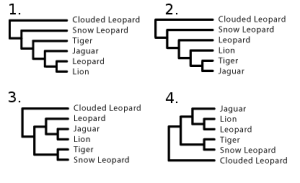Page 1 of 1
Hybridization in Nature
Posted: 25 Aug 2017, 05:00
by NCE12940
Re: Hybridization in Nature
Posted: 25 Aug 2017, 08:08
by Bas Pels
in Central America, lots of hybridization must have occurred. For one species of swordtail it is even certain it is descended from two other species.
Many CA cichlids turn up in different places if one tries to build a genetic tree - depending on what gene one looks at. This could best be explained by hybridisation events.
Still, the article refers to a gene `donated` from lions to jaguars. I somehow fail to understand how an Affrican lion can mate with a American jaguar. The most obvious answer is to state that this happened before the jaguar reached America.
I don´t think this can easily be the case, assuming Panthera to be decended in het old world, entering America in Alaska is the most Obvious. Then the pre-jaguar was Azian, and still far away from the nearest lion.
I would assume the alternative, the same gene developing twice, to be the less complicated solution.
Re: Hybridization in Nature
Posted: 25 Aug 2017, 14:45
by jp11biod
I had the same thoughts regarding the geographic isolation of the jaguar, (I am not a scientist, just a fan.)
I fear what this kind of information this can do to the Endangered Species Act, especially now with a Congress and administration so hostile to science and conservation.
Re: Hybridization in Nature
Posted: 25 Aug 2017, 15:59
by dw1305
Hi all,
Bas Pels wrote: ↑25 Aug 2017, 08:08
Still, the article refers to a gene `donated` from lions to jaguars. I somehow fail to understand how an Affrican lion can mate with a American jaguar. The most obvious answer is to state that this happened before the jaguar reached America.
There was a native sub-species of lion (
Panthera leo) in N. America until (geologically) very recent times,
Panthera leo atrox (
https://en.wikipedia.org/wiki/American_lion).
cheers Darrel
Re: Hybridization in Nature
Posted: 25 Aug 2017, 20:42
by Bas Pels
Thank you, Darrel. Never heard of P atrox.
However, reading het Wikipedia entry, it is not certain whether this species was an ancestor of P onca, or a sibling of this species, a relative of the lions (P leo atrox) or a conpletely distinct species of Panthera - not related to any of the current Pantheras.
Still, the cave lion, P leo cavensis, was found from Europe to Alaska, that is, was present in America
Re: Hybridization in Nature
Posted: 26 Aug 2017, 08:15
by dw1305
Hi all,
It isn't my field, but I think all of the genus
Panthera are closely related ("
had a recent current ancestor with").
There is a discussion at <
https://blog.opentreeoflife.org/2013/10/>, and that "4." is the best estimate phylogenetic tree.

Bas Pels wrote: ↑25 Aug 2017, 20:42
..... it is not certain whether this species was an ancestor of P onca, or a sibling of this species, a relative of the lions (P leo atrox) or a conpletely distinct species of Panthera - not related to any of the current Pantheras.....
It was alive until about ~12,000 years ago, so it is a sister species to the Jaguar (
P. onca).
I think they are now pretty certain that it was a subspecies of
Panthera leo, so more closely related to the African Lion than any other extant species.
The reference is "
Phylogeography of lions (Panthera leo ssp.) reveals three distinct taxa and a late Pleistocene reduction in genetic diversity" (
https://www.researchgate.net/publicatio ... _diversity).
cheers Darrel
Re: Hybridization in Nature
Posted: 26 Aug 2017, 22:29
by Lycosid
It's actually not necessary in this situation for a lion to breed with a jaguar. All that is necessary is that sometime after the lion/jaguar split an individual in the lineage leading to modern-day lions bred with an individual in the lineage leading to modern jaguars which may have occurred before these species had diverged as much as they have now. This could have happened well before these species came to occupy their modern ranges. Since
Panthera is an old-world genus it could have occurred before the jaguar lineage moved into the Americas.
The absence of this gene in the leopard lineage could mean one of several things:
1) The study simply did not check leopards for the gene and it's there but un-commented upon.
2) Jaguars and lions are more closely related that lions and leopards (option 3 in the image dw1305 posted) and all of this then occurred after leopards split off from the lion-jaguar lineage.
3) The interbreeding occurred after the split between lions and leopards (which would make the jaguar-lineage individual and the lion-lineage individual involved less related, but could still have occurred prior to the jaguar lineage emigrating to the Americas).
4) Leopards have subsequently modified this gene, erasing the evidence of its presence in their genome.
Perhaps more interestingly, this is all happening in big cats which are pretty nicely split into species. We're all on these forums to talk about freshwater fish, which are fairly nightmarish as far as traditional species concepts go. I've seen a few discussions here about whether something is a color variant (or other morphological variation) or a species and I sometimes wonder if some of these problems arise from awful edge cases where cleanly labeling species is basically impossible. (See, for instance,
this study.)
Some of you may remember
this thread, which discussed hybridization between catfish families.
